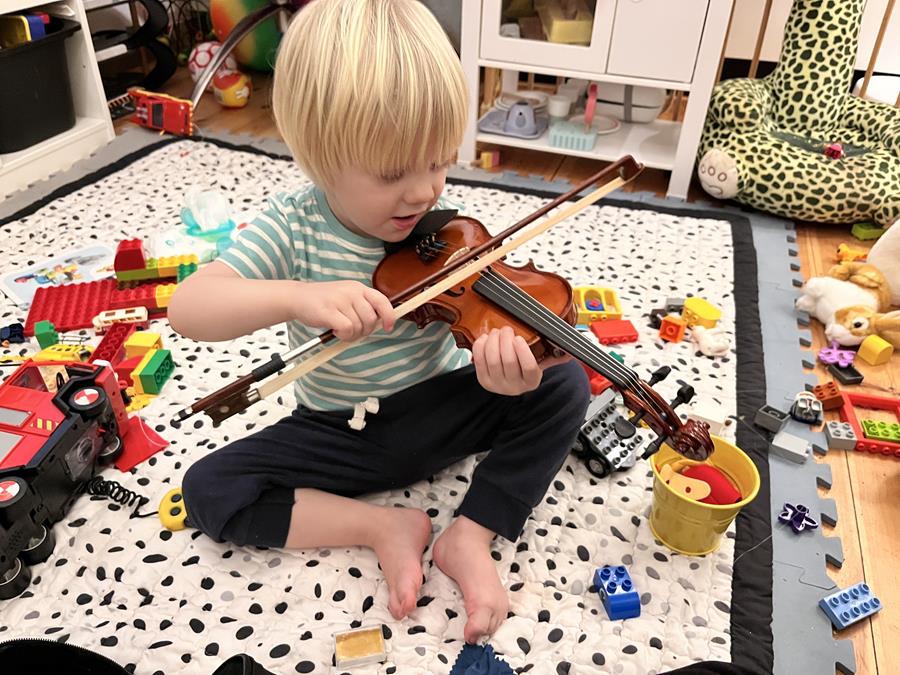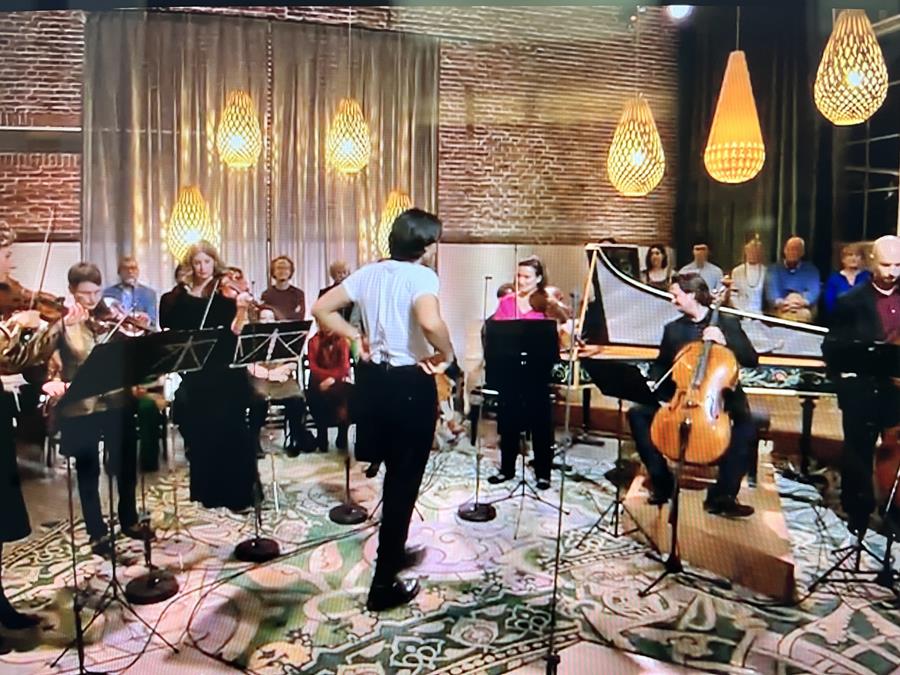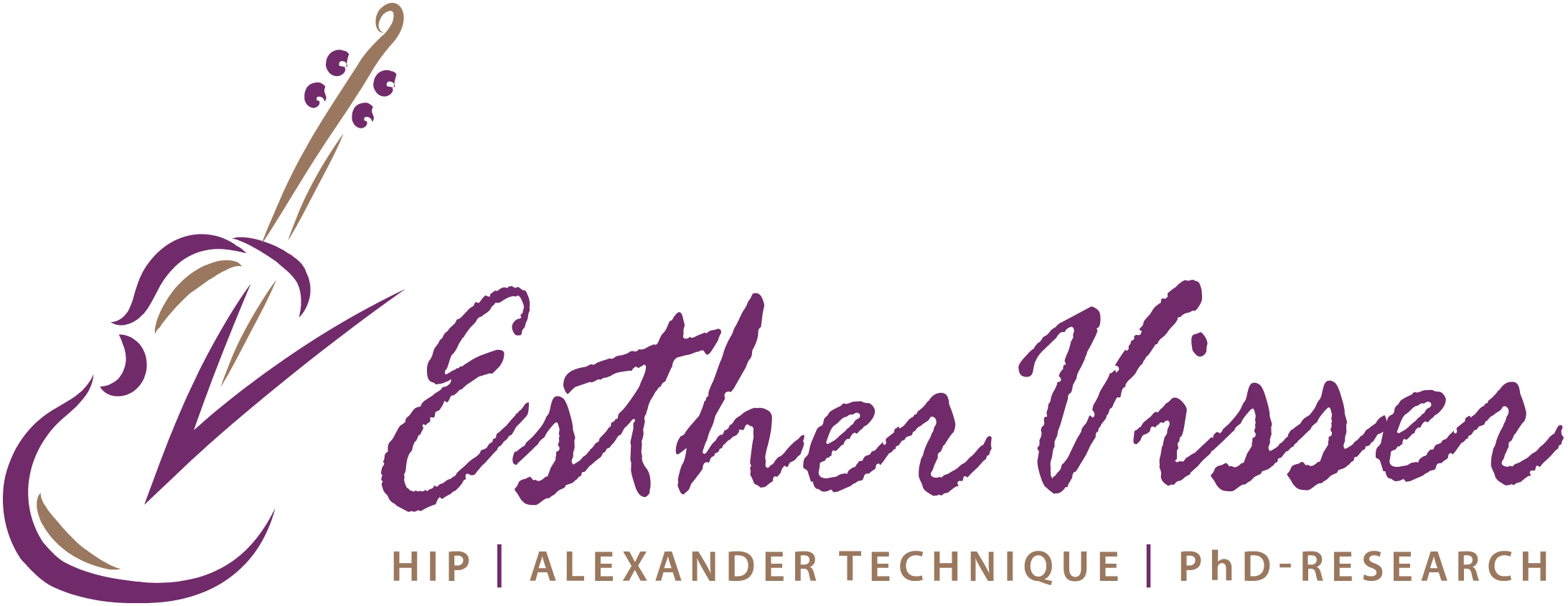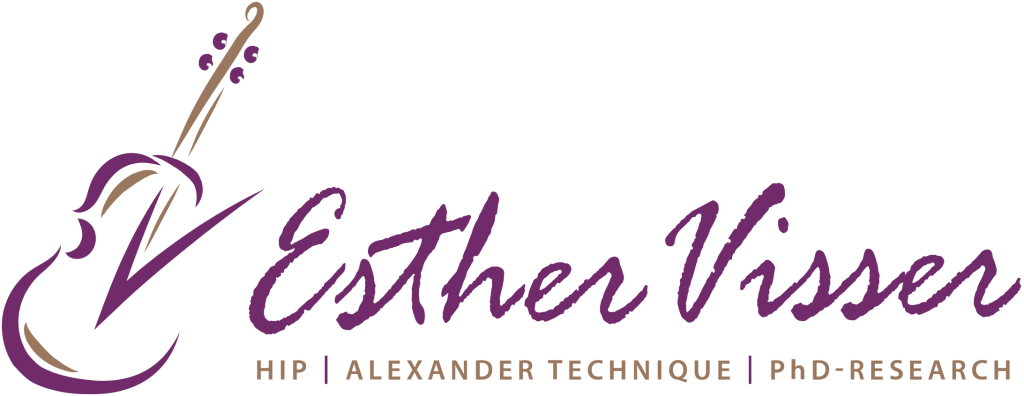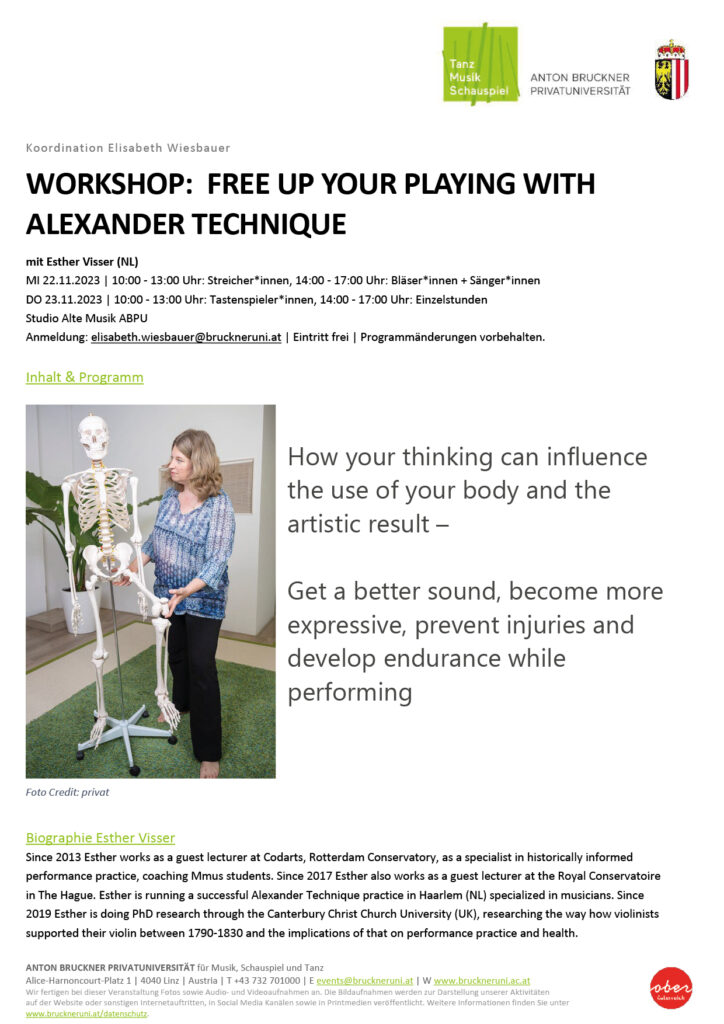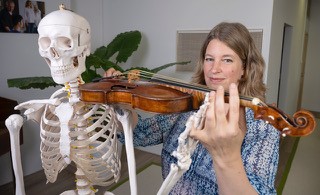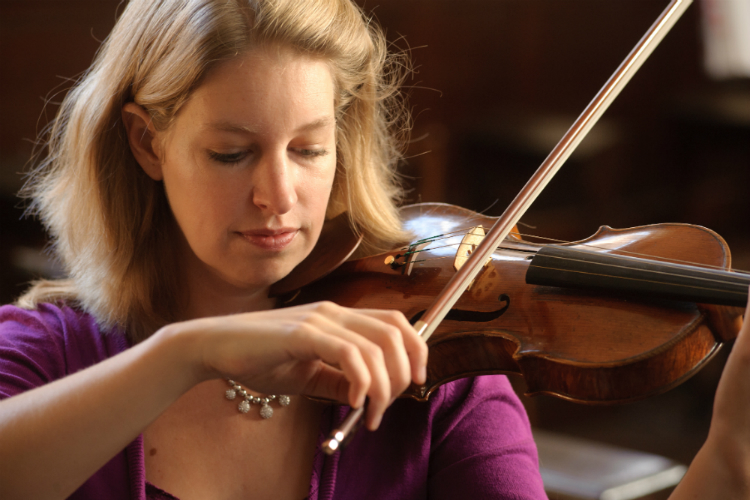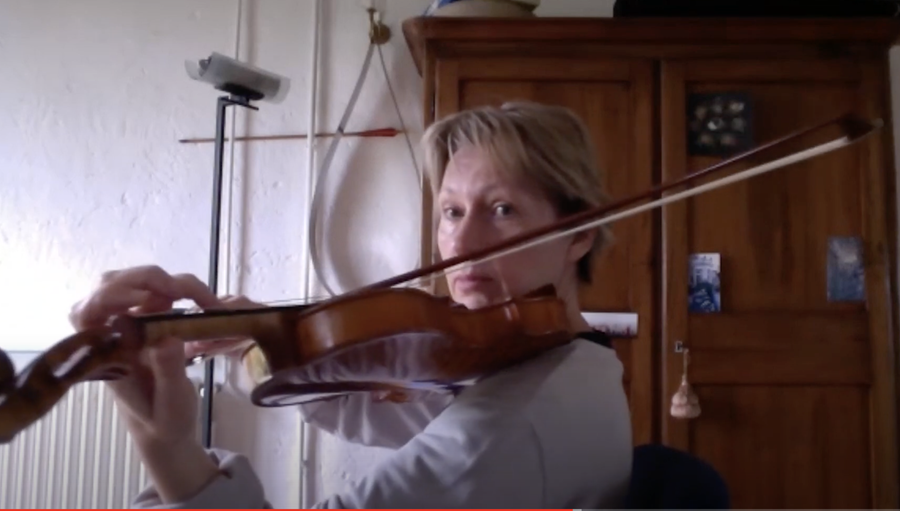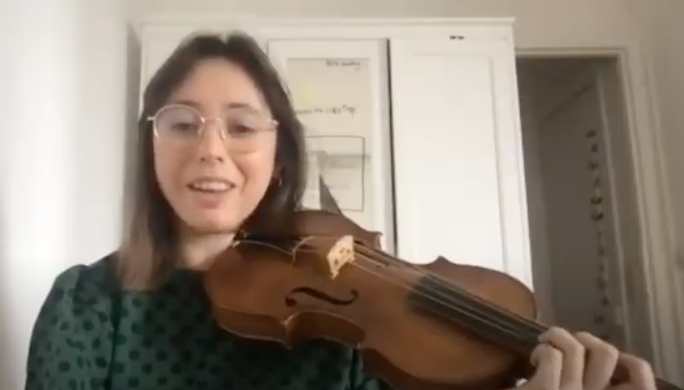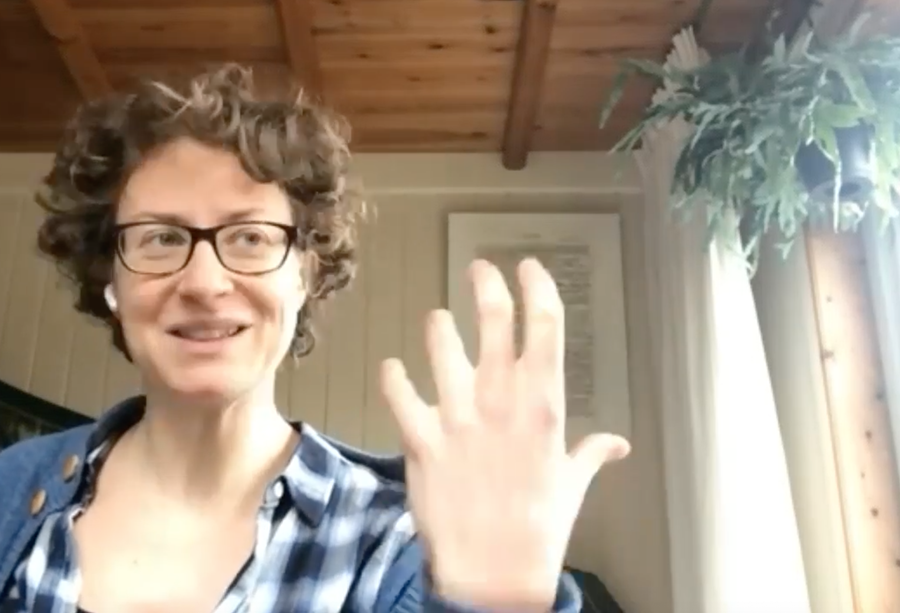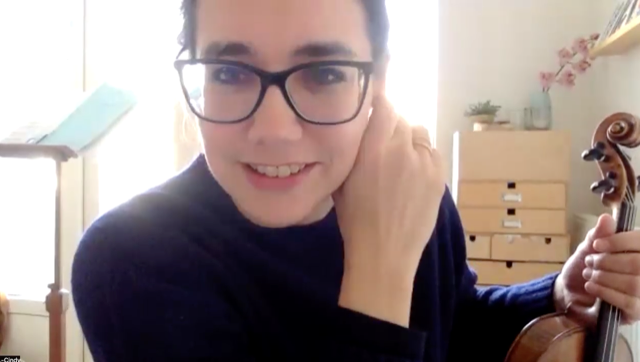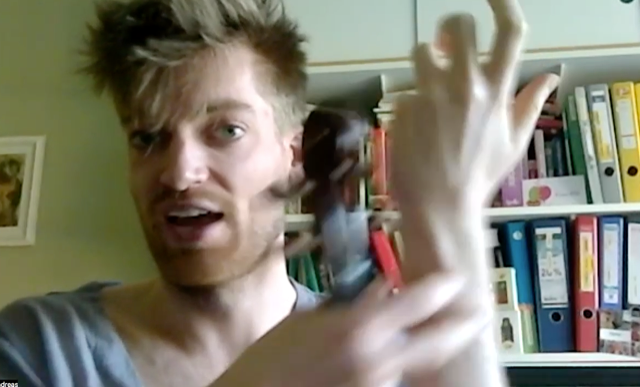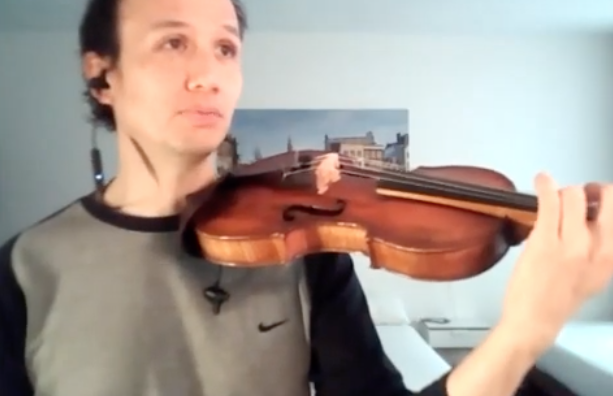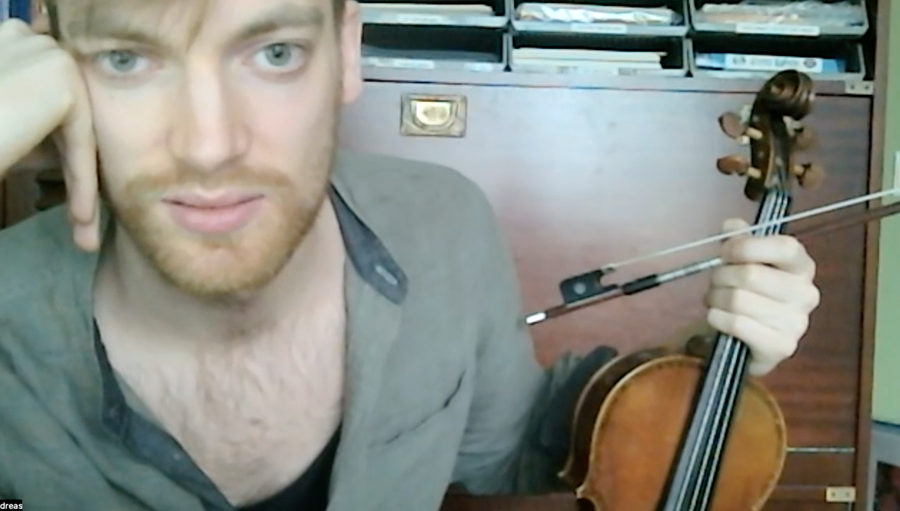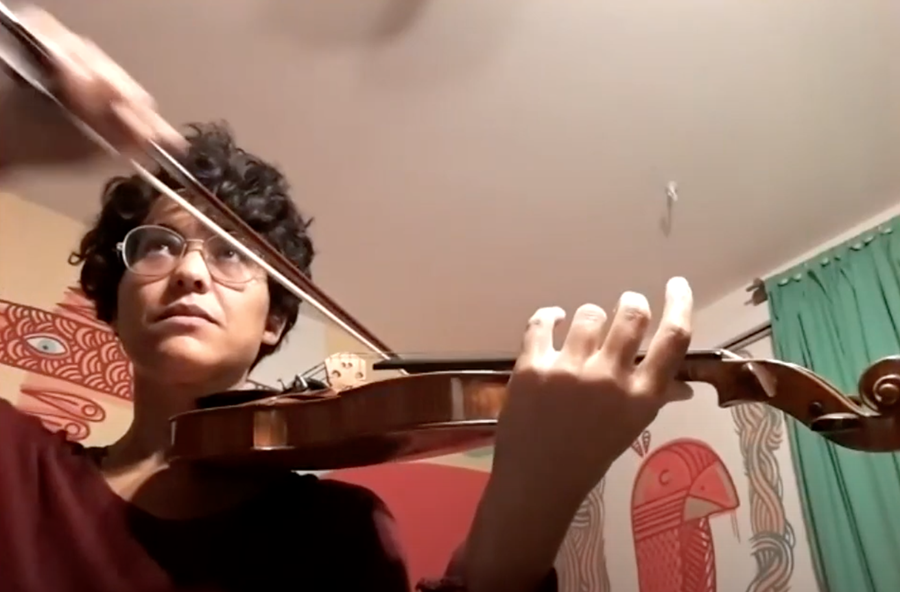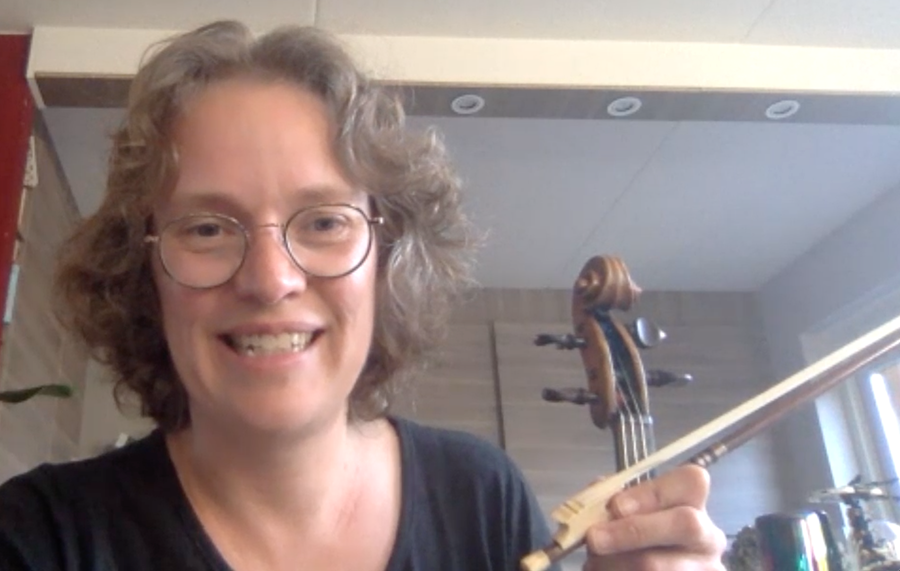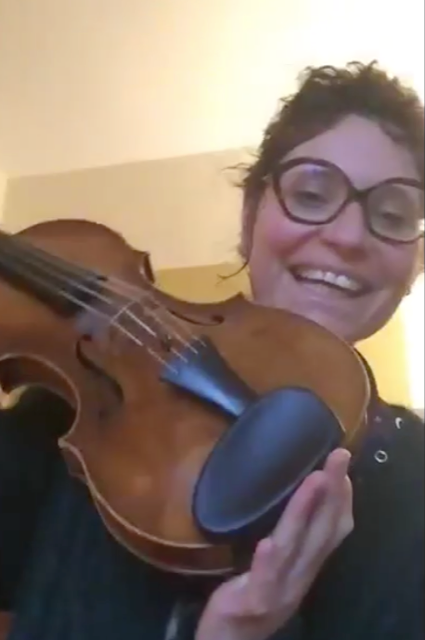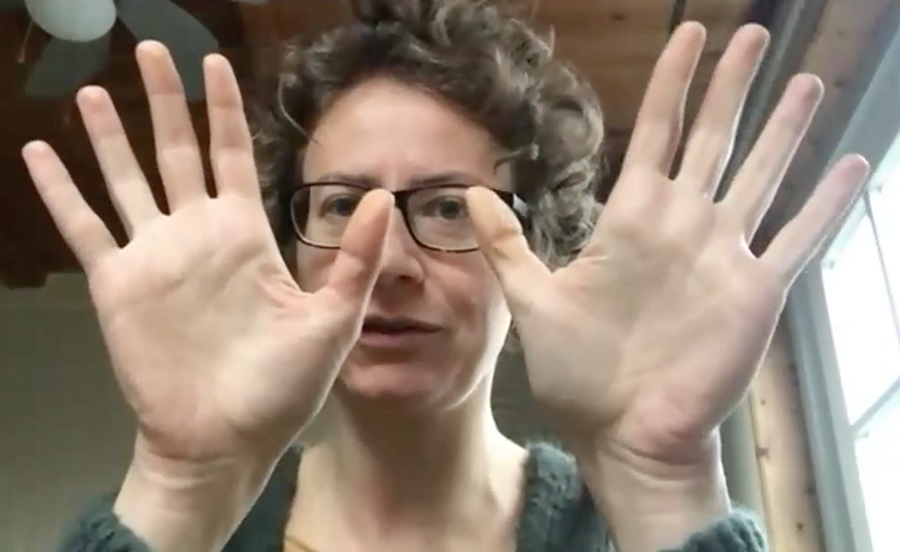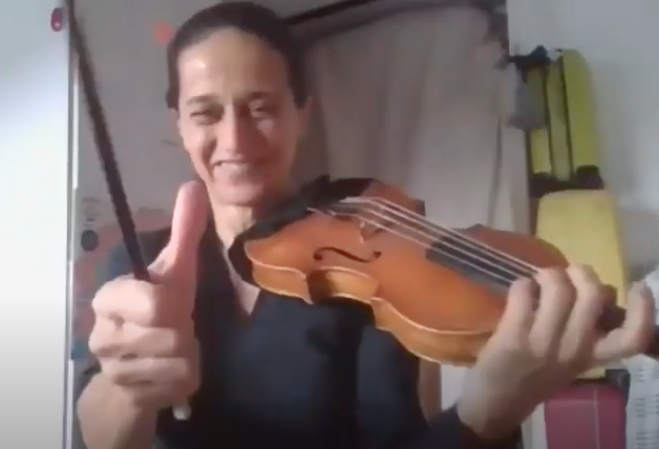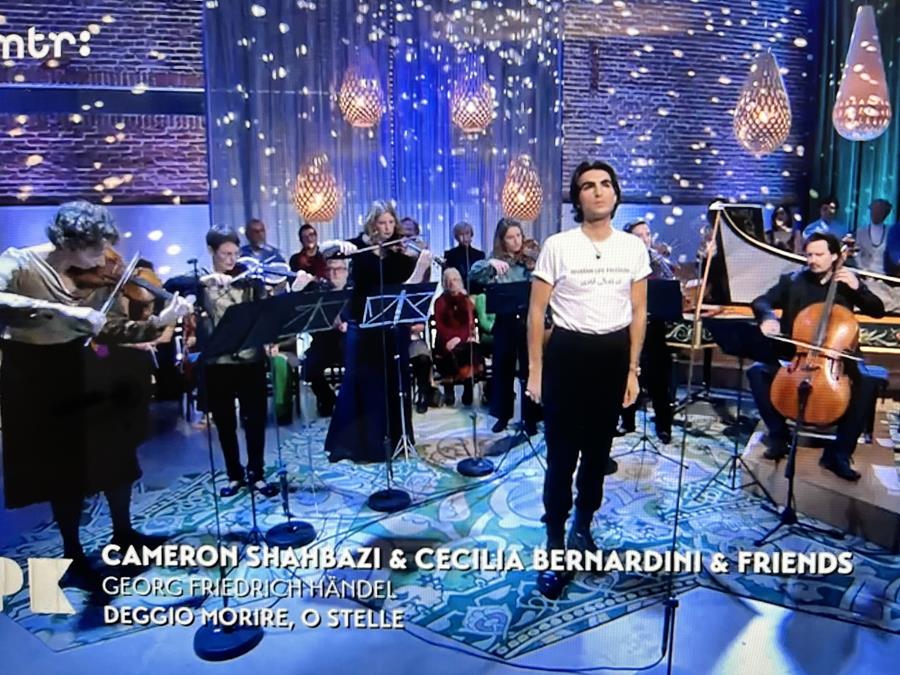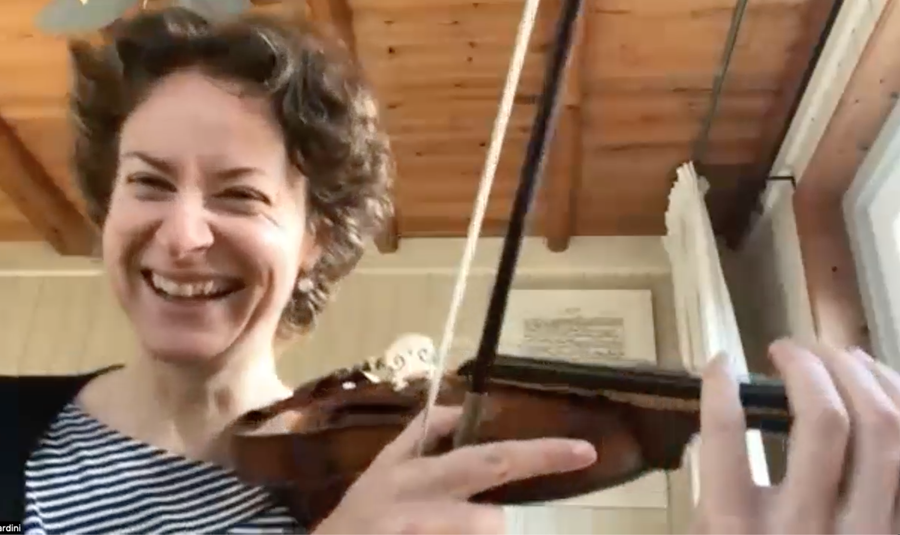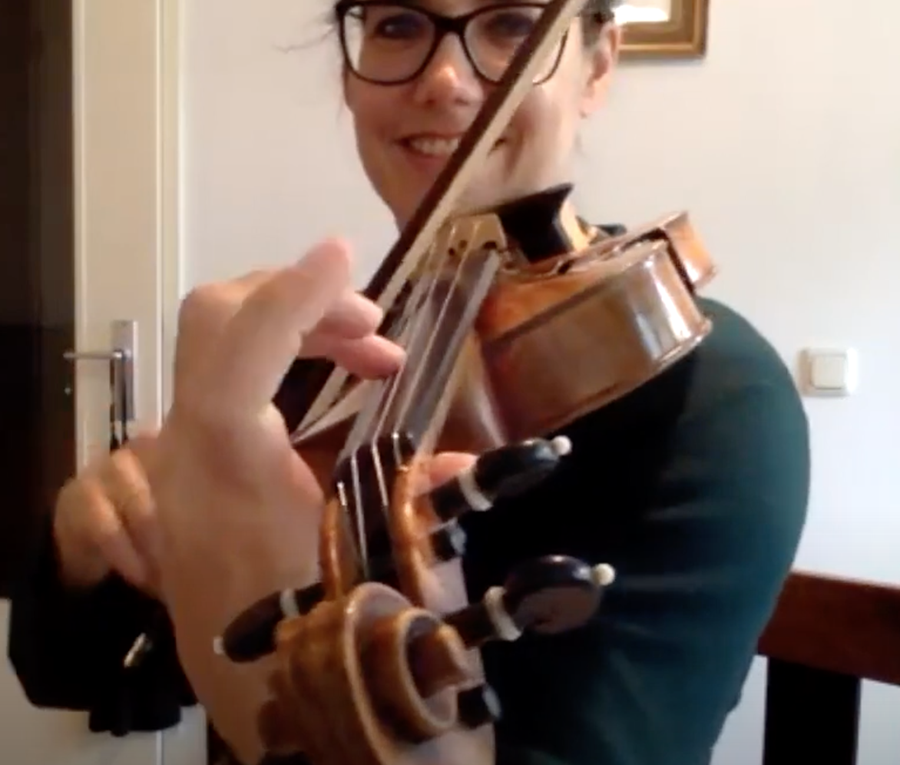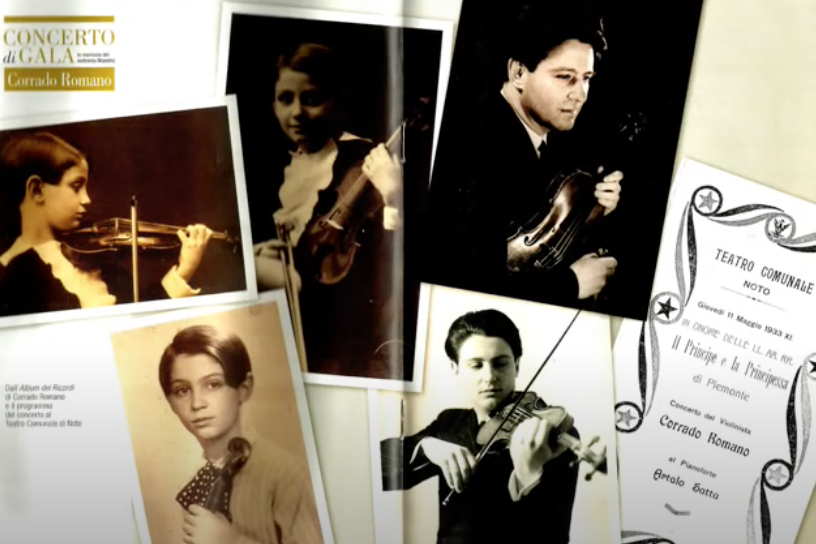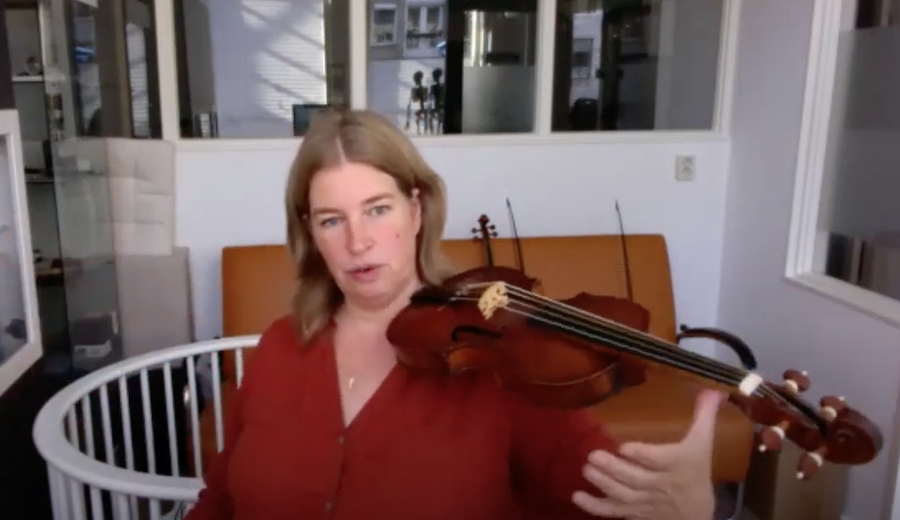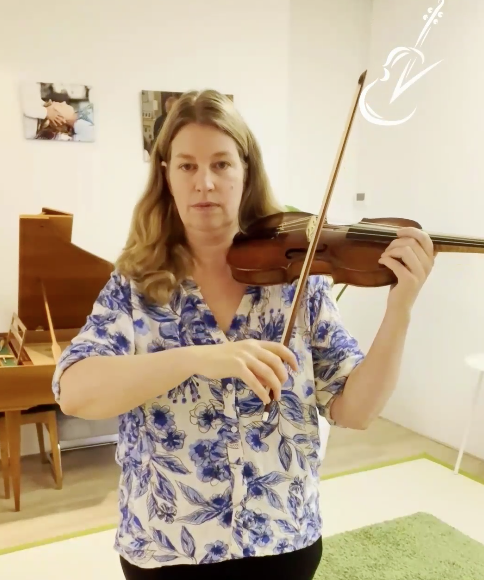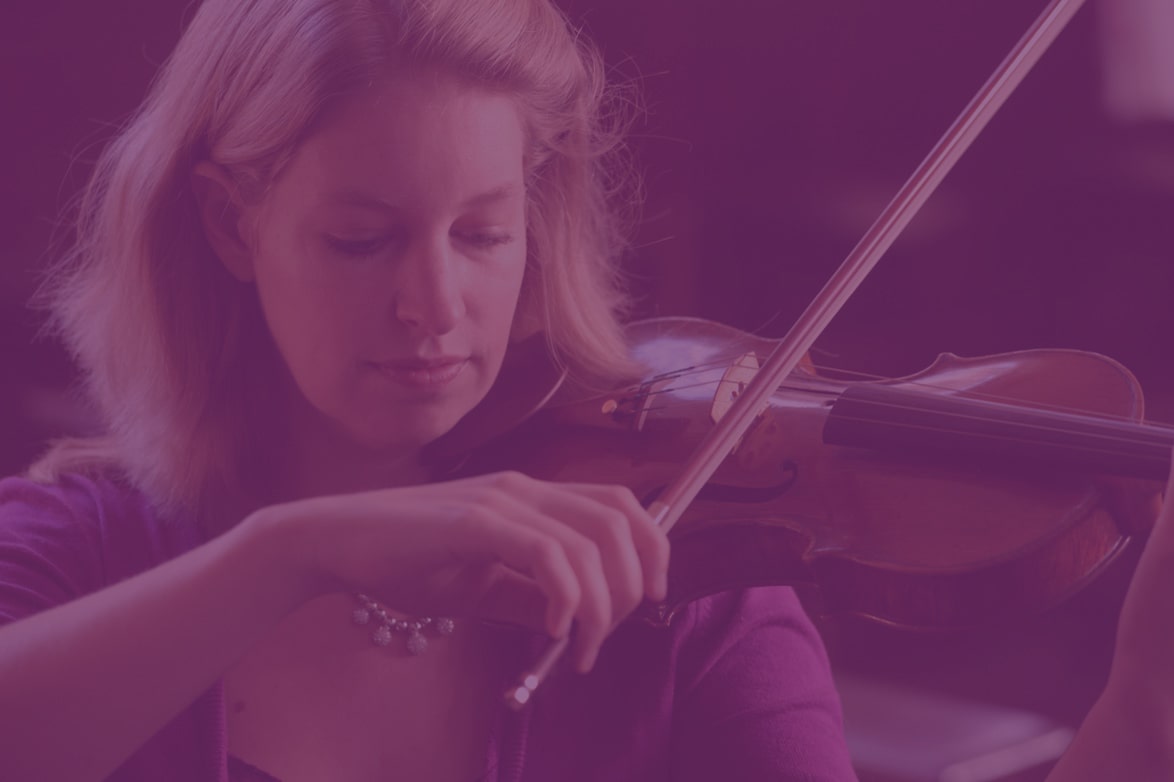
The twelfth week of my experiment on playing with a shoulder and / or chin rest
Hi everyone,
This is the twelfth week of the experiment on playing without a shoulder rest and / or chin rest. Here are some updates and some feedback. I hope you had a nice Christmas! This is the last newsletter from 2022, but the newsletters will continue in 2023, as long as the experiment is actively running.
Thank you for sending me your videos, it’s really important for my research. Please keep doing it. We are at different stages, not everyone is in week 12 now, that is completely fine. Everyone can do it in their own tempo. It’s a busy time for everyone, just before Christmas, so don’t hesitate to continue in Januari if that is better for you.
Again, some more new participants joined as well, welcome to Maria from Austria! Many people already filled out the entrance survey. Thanks. If you didn’t do it yet, please do so before you start the lessons.
If you know more people who like to join, for example starting in January, this is still possible through my website. If you missed the newsletter last week, you can still read it here. There is a collection of past newsletters at my website available too.
Please be welcome to join the Zoom session next Wednesday 11.00 AM (Dutch time) if you want… Just to meet or to ask some questions. Would be nice to meet up. You can watch Zoom sessions back on the login page where the video lessons are, as well.
This week, I was invited to give 2 days of masterclasses at the Bruckner university in Linz, next winter, because the head of the department there is following our experiment and is enthusiastic about it. So nice! Thank you for the invitation!
About the Xmas holiday
It would be best if you could continue with the 10 min per day during the holiday, so your learning process will not have an interruption. But if you prefer to take a break, this is fine too, just please let me know, no problem! Our zoom sessions will continue tot take place, also on Wednesday January 4th, and after that. Some people already informed me, that usually Wednesday mornings are not possible for them as they have to work, but in the holidays they are free and able to join! So this can be a nice chance to meet up if you are too busy otherwise. Looking forward!
“I think your research is very important and I think you are very right on all the points you raised. I am so thankful that your talk about this, because almost every musician has unhelpful habits.”
– Jun Keller, Vienna Philharmonic Orchestra,
participant in the experiment
Twelfth Zoom session
Last Wednesday we had a twelfth zoom session with some participants of this experiment. It was lovely. If you want to watch it: I recorded the session and there is a link to it in the login page under the video lessons.
Maaike from Amsterdam and me started with discussing about my observation that many participants in this experiment in the beginning have their left elbow too much inwards when they try to have more space in the left hand, and after a few weeks the elbow seems to drop to a much better place, more directing to the ground, and their left hand seems suddenly to allow this. Also in Maaikes case. However she still needs to bring her wrist a bit towards her nose to be able to do that. We agreed that gravity is universal for everyone and that if her wrist would be more relaxed, it would fall automatically more to the ground. So my question to her was: “Wat is it in your body that is holding back that the gravity can work?”. By thinking about this, she already felt a change. The support of the thumb is going up (releasing from the wrist) and the weight of the arm is going down, at the same time.
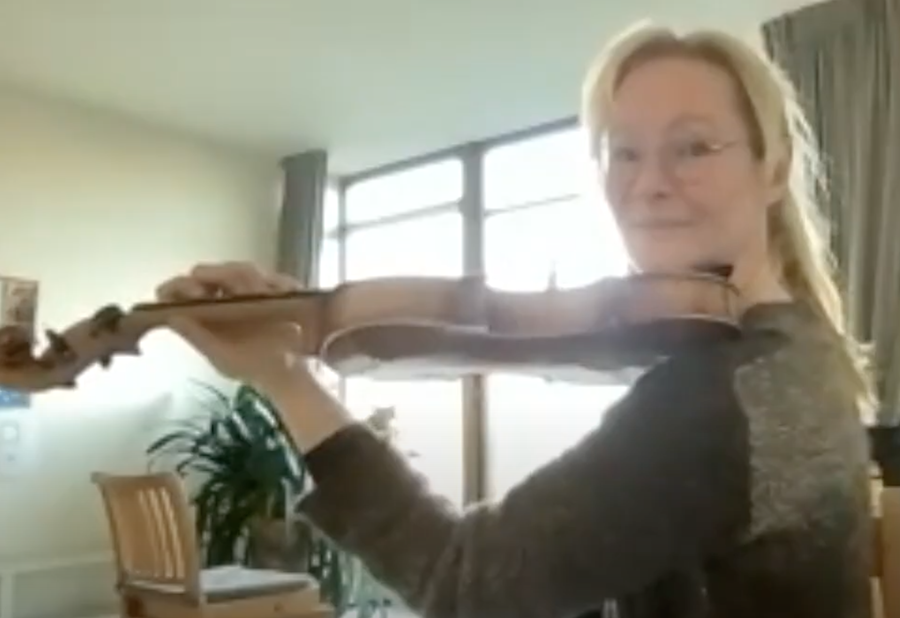
We talked about the question if every violinists and violist is different or that there are some universal things applying for any violinists. I think we are much more similar than many people think. The way our skeleton and muscles function is not so different between humans. Some have bit longer bones or a bit more souplesse, but basically we are very much the same. For example, we both thought that for no one it’s not a good idea to have the wrist pointing outwards while playing in the first position.
Maaikes question for today was that while practicing for this experiment she felt her violin sometimes wobble (not laying stable on the collarbone) when she is using her 3rd and 4rd finger on the string. In my (Esthers) case, this is not happening, my violin stays still. We were wondering what could be the reason. Then Nadi from Paris came in (Thank you, Nadi!) and told us that for her that also was the case in the beginning, but then she just moved her violin a tiny bit more to her centre (a bit more to the right), to have more contact with the collarbone, and that solved it for her, the violin was stable. Maaike tried it and it worked! Now her violin was stable. That also corresponds with one of the first exercises in our experiment, to keep the elbows relaxed and the the fore arms move from that to the side, to know the direction of the violin. Maaike felt it and there was no ‘wiggle-room’ anymore for her violin. Great. This was only possible because last week we discovered with Maaike how she could let go of her collarbone to let the violin be more in her centre, otherwise this would not have worked this week… so nice to do these discoveries together.
It was a second ‘Eureka moment’ for Maaike!
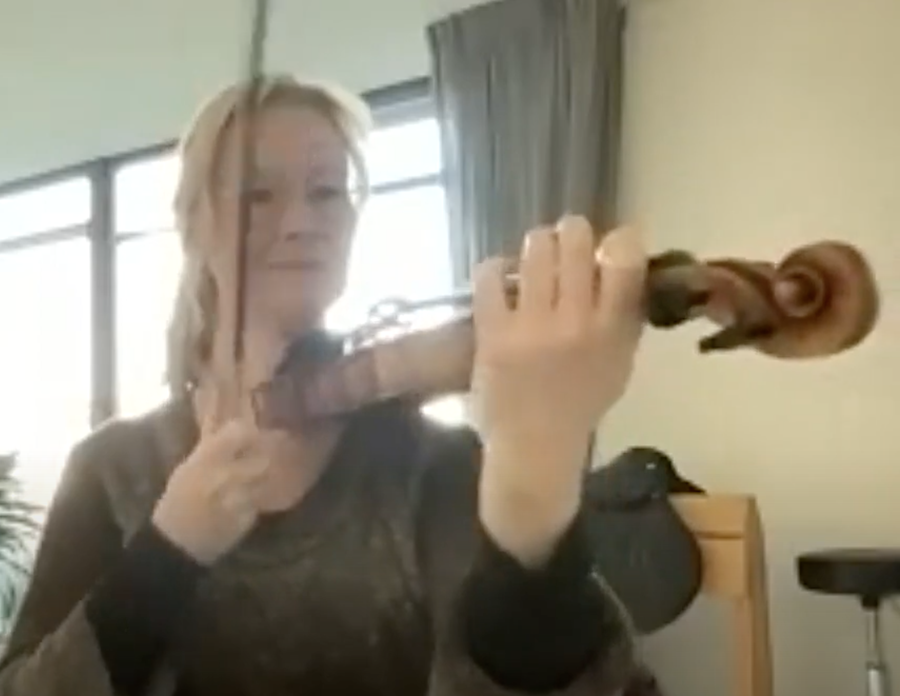

Nicolette from London told us that she had been thinking a lot about the thumb, this week, as she noticed that a part of her thumb collapses while playing. She shared that she feels the gravity taking her elbow nicely directed to the ground when she brings her thumb forwards, and tension growing when she brings the thumb backwards. We all tried it without holding a violin. We felt something releasing in the shoulder and in the elbow, when the thumb is more forwards. The thumb opposite the second finger also feels more neutral than opposite the first finger. Maaike added that when the thumb is opposite the second finger, the pinky also has much more support (for example in playing decimes) and then the 4th finger does not collaps. Really interesting. It becomes more like in the bowing hand, also there the thumb is opposite the second finger and not opposite the first, it gives a similar experience. This is exactly what I intuitively already experienced in the beginning of my research, my two hands became more ‘the same’.
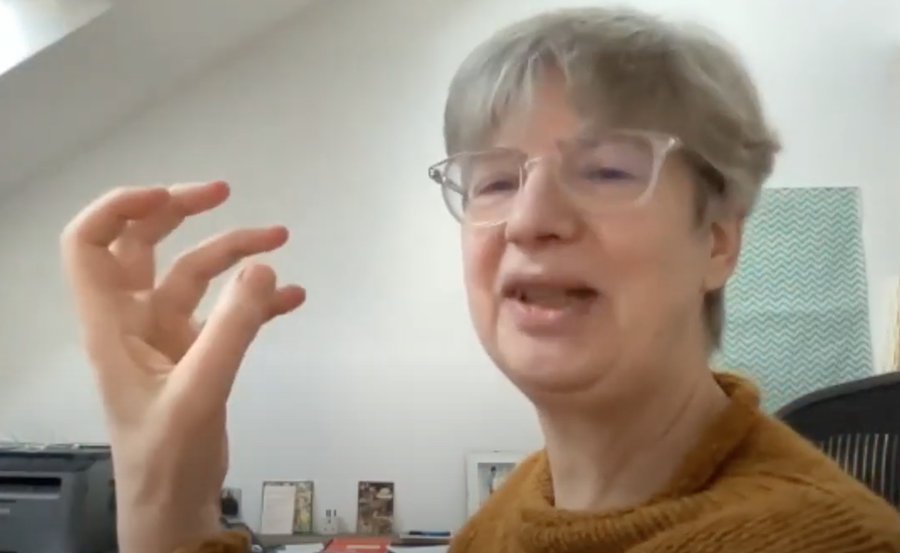
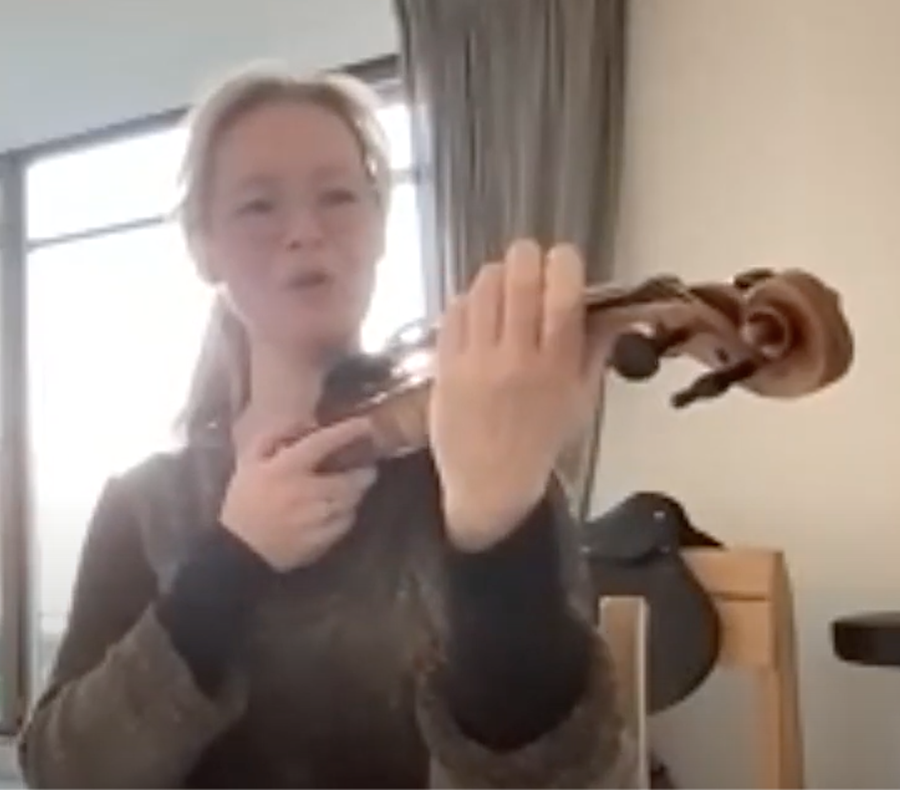
Then Silvia from Italy also joined the conversation and we talked about her thumb, as she is double jointed, just like myself. She was still searching for the nice sport for her thumb how to support the instrument and we saw that sometimes she was using a bit too much the tip of her thumb. So I invited her to use more the ‘cushion’ of her thumb and place it diagonally on the neck of the violin. Silvia worded it in a very nice way: “Ok, so in fact we then have a nice spot on the collarbone as a support and also a nice (soft) spot on the thumb as a support and the violin is balancing in between them.” Yes!
Nicolette added that it’s important to realize the the base joint of the thumb start near the wrist. In Silvia’s case, it looked like she was moving the thumb more from the second joint. Even though Silvia studied Physiotherapy (she rationally knows perfectly how the thumb works), it is something else to really feel it. At the moment she is having an inflammation in both wrists, so we tried to help her and di some exercises together to try and grab something (in my case tissues in her case a book) without letting one of the thumb joints collaps.
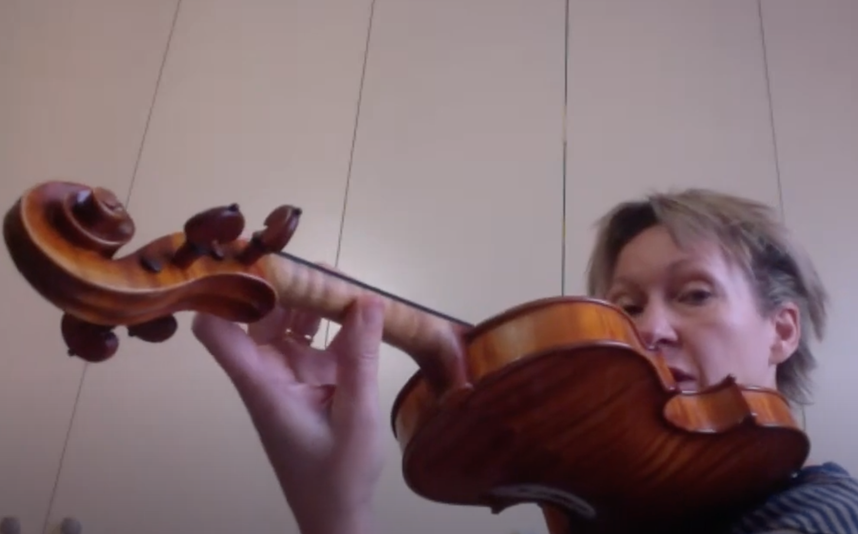
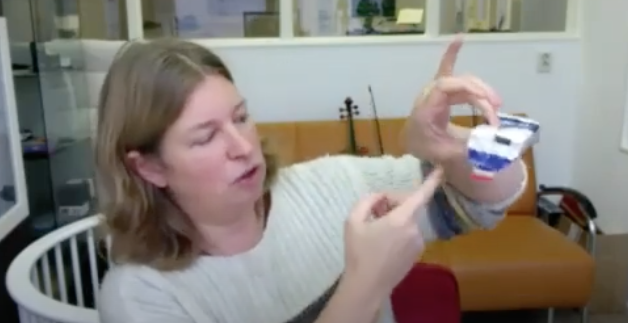

I advised her to do that a few times per day, to practice this new way of using the joints. Nadi had to leave to a Christmas party in Vienna, but before she left she just told us that she is now at the vibrato lesson in the experiment and she discovered that a big reason for the tiredness she sometimes feels in the orchestra comes from her way of applying vibrato. She discovered that she was involving the trapezius muscle (between neck and shoulder) in her vibrato and that that is not needed. Congrats, Nadi! Really nice! She told us that she already could apply the new way of vibrato in a concert last week in Lyon and she was not tired at all. So good to hear!
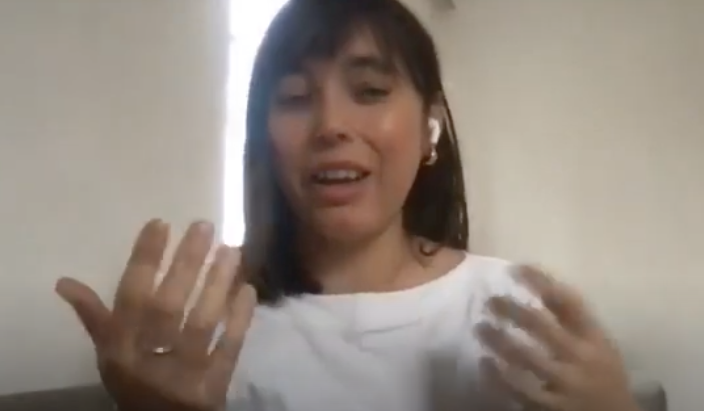
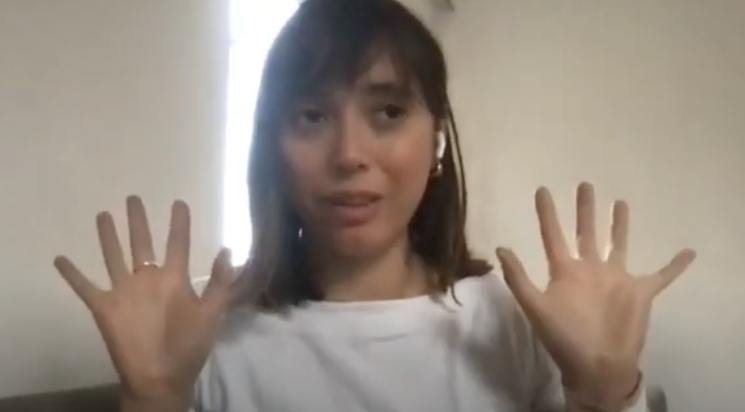
I feel really touched about the involvement and commitment of Nadi and all participants (you!) in this process. It’s fantastic. I told that in the zoom session and the others said that they find our zoom sessions so interesting. Nicolette said “When do we get to talk about these things together? It’s a very rich experience.” Really happy with that!
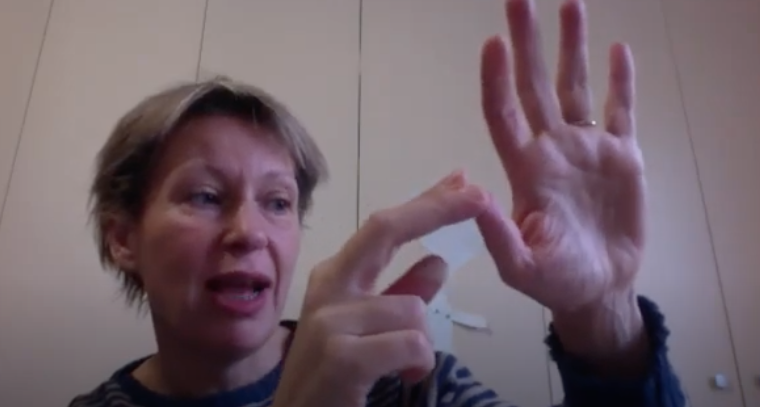
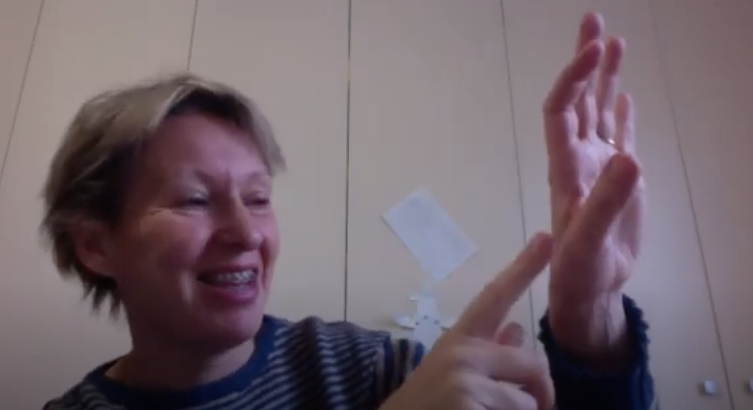
We then continued searching with Sylvia to find a solution for the pain in her wrists. I suggested that it seemed to me that perhaps she is placing the neck of the violin a bit too much on the tip of her thumb, which makes the balance really unstable and gives pressure on the wrist. I advised her to use the cushion of the thumb and don’t practice more than 2 or 3 minutes at once. Maaike added a nice exercise, first turning the hand backwards and touch with the thumb the second finger in a very round and soft way, and then bring the hand to the violin while the violin still is on your knee. Then you go to the violin with your hand and perhaps rest the hand on the shoulder of the violin, and then bring the violin to the shoulder with your right hand and keep the soft feeling in the hand, shoulder and arm. I added to that, that the crucial point then is to let the hand taking over the weight of the violin, be very aware if your muscles stay as soft as they were. You then hold the violin between of of your fingers and the thumb, without collapsing joints. It’s about understanding how the hand is functioning.
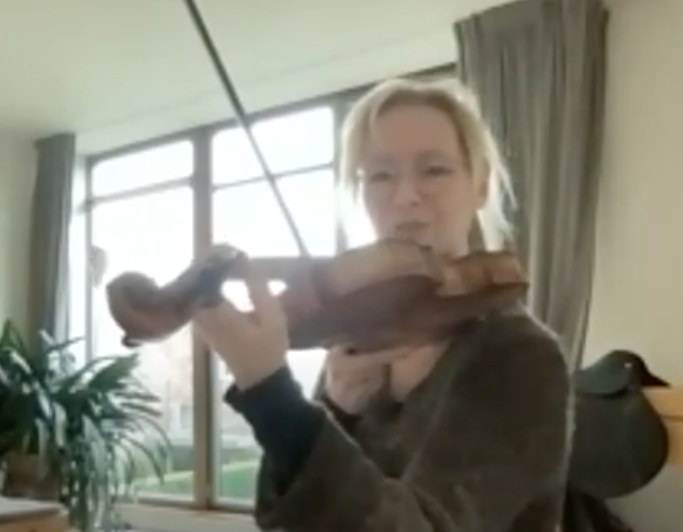
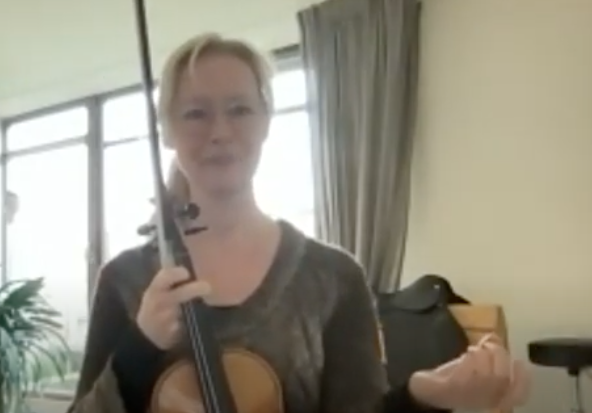
In the end it is about the balance between the thumb and one of the fingers, which needs to be practiced, like walking on a tight rope. Its also important to think a direction towards yourself through the fingertips and through the violin, so that the violin comes a bit towards yourself. This is stabilising the balance. Nicolette and me had nice discussion, that she thinks her fingers more towards her neck and I think my fingers more towards my heart ( a bit lower, diagonally through he violin).
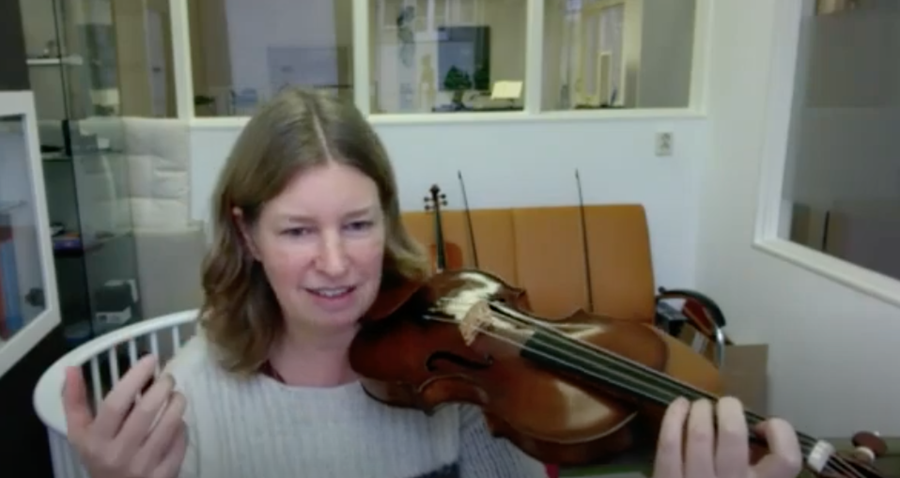
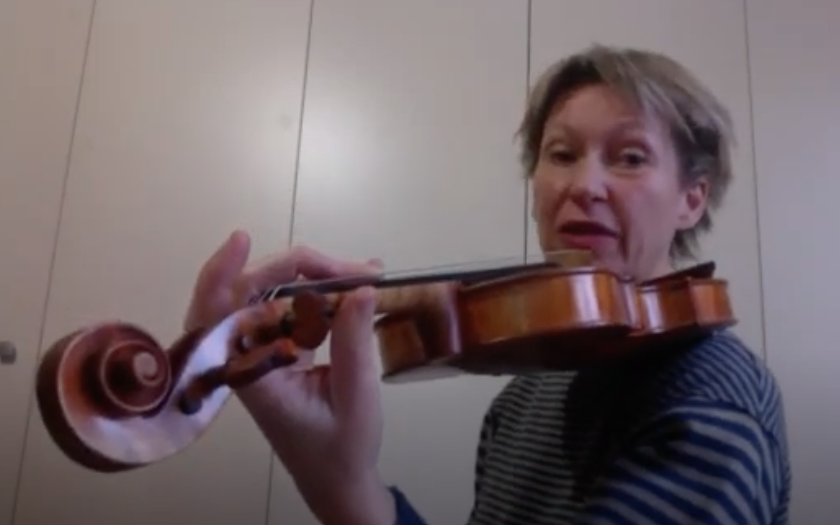
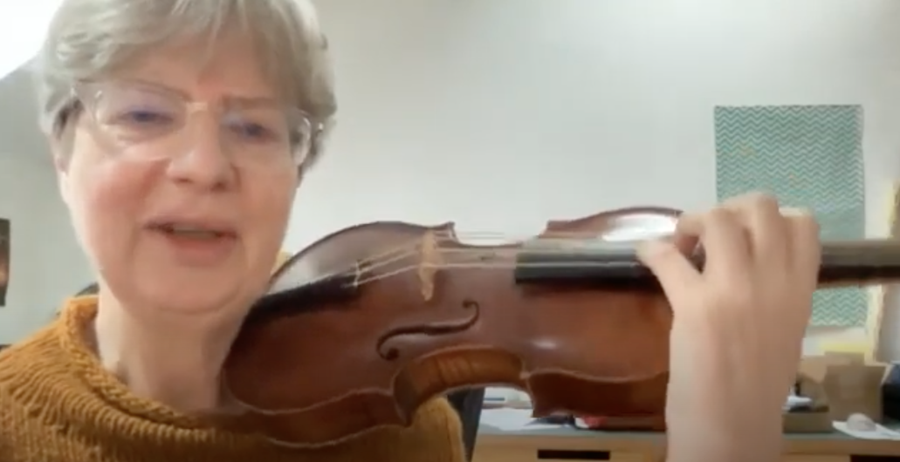
Silvia told us that her general feeling with the violin (even while using a shoulder rest) she already feels more freedom, especially in using vibrato. The bigger awareness is helping her a lot, she is thankful for that and the sound is getting nicer as well. That is so nice to hear, thanks, Silvia!
We spoke also about the difference between ‘thinking’ something and ‘doing’ something. In Alexander Technique we use ‘thinking’ a lot and try to avoid’ doing’. The danger of ‘doing’ is, that there is too much action involved and it is building tension. For example the direction towards you hearts, is an example of ‘thinking’, not ‘doing’.
Maaike shared with us that she is exploring this week also the possibility that the head sometimes can go to the left or right, in stead of only up. It gives a lot of freedom. I (Esther) agree with that. In my lesson videos you also see my head going to the right (away from the violin) quite often. Nicolette was so happy with that exploration from Maaike, because that is really the Feldenkrais approach, to explore things. We all agreed that the Alexander Technique world could use some more ‘exploration mentality’. However, there are some Alexander teachers, like Maaike and me, going on that exploration path. However, I (Esther) added, that in this experiment we have to be careful with moving with the head towards the violin, as some people are just unlearning to rest their head on the violin. It’s just good to know that after a while this can be an option and it’s not ‘forbidden’. Nicolette added that the nice thing of moving the head to a side is that the whole spine moves and there is a nice flexibility in the body. That is important, to avoid the ‘broomstick effect’, when people stiffen the back in an effort to sit ‘up’.
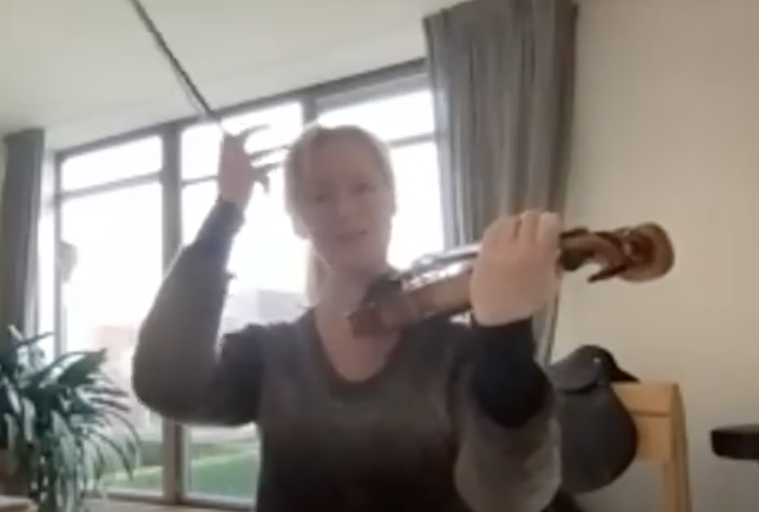
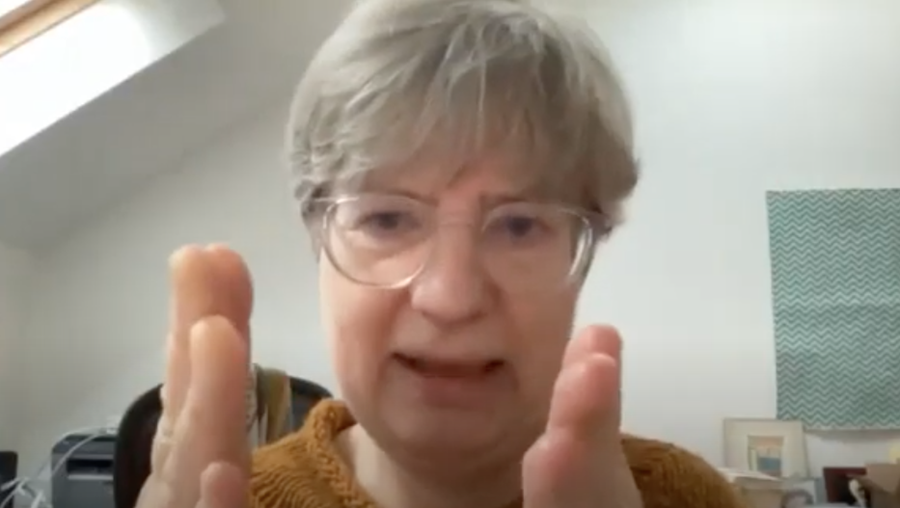
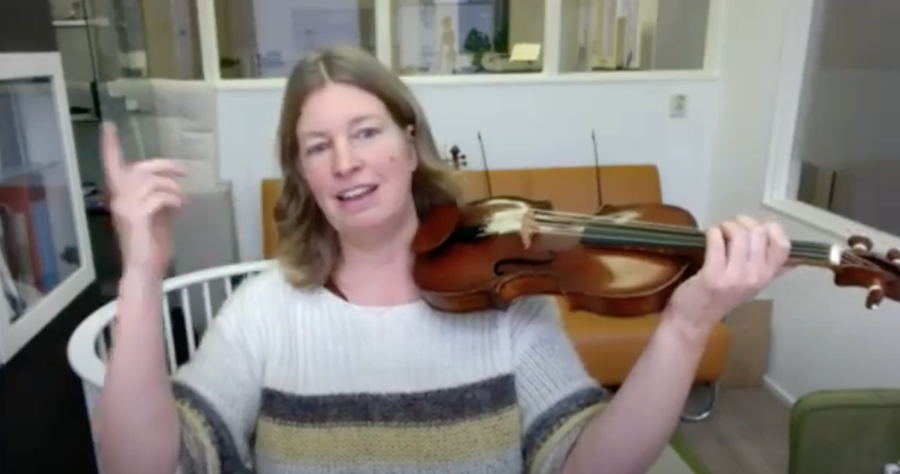
After that, I had a question for all participants that were present in the zoom session, as I received an email from an anonymous participant in our experiment, asking me tips on stage anxiety. I asked Nicolette, Maaike and Silvia: “What is your best strategy when you work with students to tackle stage fright?’. I think this subject could be interesting for everyone, so I share it here in the news letter and you also can watch it back in zoom session 12 on the website, starting from 1’39”50.
Nicolette answered that in her teaching it’s important to get them to understand how the mind works and that it’s about the music. The central though should be the music and allowing the thoughts and fear at the same time, but to let those thoughts look after themselves, we don’t have to do anything with it. She also let them play something 10 times in a different way, to get them out of the habit that is should happen in one way. Sometimes it can be useful to think about the feet and breathing, but not too much.
Maaike told us that she thinks stage fright has a lot to do with the way people are practising. For example if you separate music from technique and practise this separately. The real work to tackle stage fright needs to be done in changing the habits in the way you practice and the way you think about it. It can help a lot to practice together with your students to give them much more strategies for this. Work on colours, breathing, music, awareness, enhancing flow etc, together. This is the biggest relaxer you can possibly give someone, Maaike said. Nicolette said she completely agrees with that and added that that has probably been the biggest problem with the making of conservatories in the end of the 18th century: The separation of music and technique. It’s like separating body and mind.
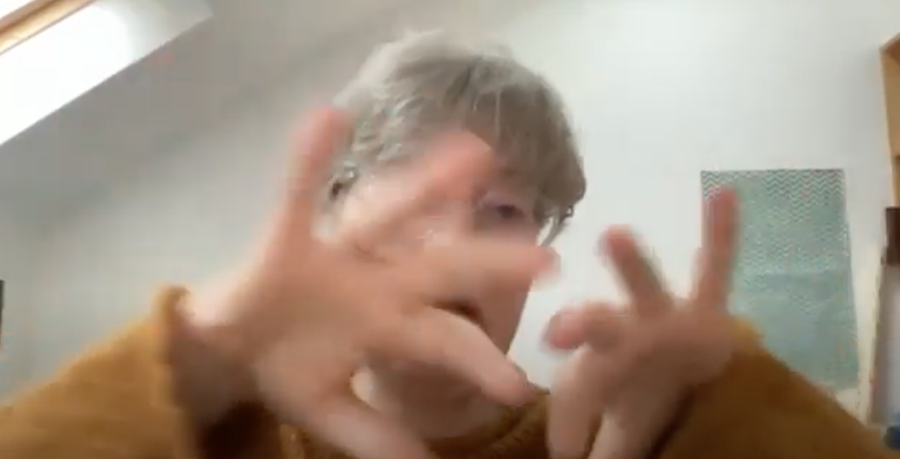
Maaike added that it’s so painful to see. This ‘conservatory’ approach is bringing students so much tension and stress. The only thing they can think about is ‘it needs to be in tune, it needs to be rhythmical’ etc. They start practising Mozart concerti with a metronome and it starts to sound like that, really ugly. Maaike advices them to bury the metronome 300 feet under the ground, haha! And Nicolette added that it’s so important also to sing the music you practice. The singing is always musical and somehow the playing is not like their playing at all, she is tying to bring those two things together again. Maaike also tries to bring them back to their original love for the instrument and challenges them to dance on the music they practice and sing it at the same time. It’s freeing up a lot.
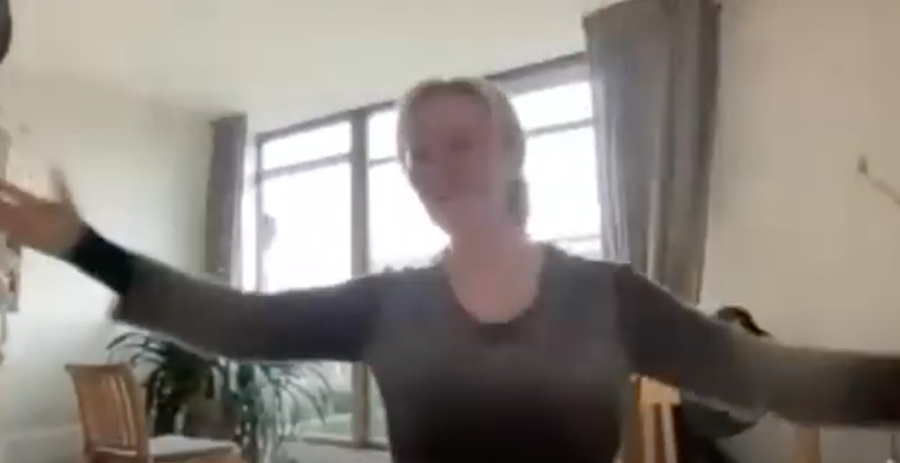
Then I asked what their advice would be for a person who suffers from nerves while playing in an orchestra, but has no time to practice many hours for himself?
Maaike told us that her experience is that musicians who are nervous in orchestra playing are very much ‘zoomed in’ into themselves. They tend to forget that there are also double basses and piccolos playing and that there is space behind them as well. They tend to think ” O my God, I have to start Mahler 1 with a flageolet and my bow will start to shake’ … completely busy with themselves in a non helpful way. I suggested that in that case the panoramic view and hearing could be very helpful. Maaike agreed with that and suggested that in stead of focussing on yourself, listen to someone else already playing.
Nicolette suggested that it also could be the case with people playing in orchestra for years that they moved very far away from feeling themselves. So it could be helpful to take some Alexander or Feldenkrais lessons to help them be in contact with themselves again in stead of constant having the fear ‘what will the others think’. Maaike added that that very though also is a matter of separating: Them and me. While in fact an orchestra can be seen as one system working together. It also can help to see it in that way again. That you are together in this musical journey. Esther added that in many orchestras this is not the case and people are no friends… Maaike confirmed that and told us that she was teaching people who were taking a whole beta blocker every rehearsal to survive and it took her a year to get them back to only using a crumble of a beta blocker only for a concert. It can not be done in one lesson, it takes much time. There are many steps to take and it was built up in many years, so it also takes a lot of effort to change these habits.
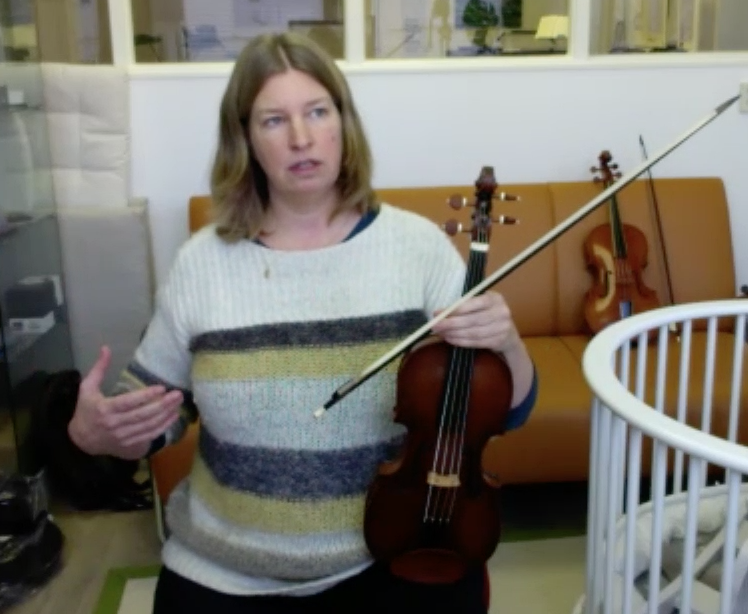
I am always so surprised that I get people in my practice with stage fright who have won an audition, were accepted after the trial, played in a group for 10 years and then suddenly feel very nervous in concerts with that same group. Apparently they don’t feel safe at all. Maaike is not surprised and can imagine this very well. Silvia added that she is a very emotional person as well and for her the Alexander Technique lessons really made the difference for her, getting to know herself better, and also the realisation that feelings are not forever but they go away again. She is just accepting them and witness what is happening, and she is coming back to her Alexander directions and breathing. Her Alexander teacher is Alessandro Fattorini in Italy.

I added that I agree with that, it all has to do getting to know yourself. I am interested in what is the cause for it that people start thinking ‘my bow will start trembling, what will they think of me’…
Silvia told us that for her to be conscious of her body makes the mind really much calmer. She joked ‘we can not do psychotherapy for every problem in life, can we?’.
Maaike told us that during her conservatory study, she suddenly realised that she was so nervous playing triads in the technical exam, because she had been practising in a very tensed way already. She kind of practised it. So in that case, it’s not that thought that is the beginning, but the way she had practised it. When she was in Alexander Technique training, she realised she was ‘lifting’ herself every time there were triads or fast notes, etc.
So based on our conversation, my conclusion for the person who is afraid for the flageolet in Mahler 1 is: Practising it at home in another way, while breathing calmly, in contact with himself, etc. The body will remember that when sitting in orchestra.
Silvia added also that violinists are ‘champions of apnea’ (haha!), meaning that we stop breathing many times while playing… she works a lot on breathing with her Alexander teacher Allesandro on breathing. Maaike added that starting bowing on an out breath also is a big relaxer, which you can practise at home. You have to fight years of wrong conditioning, so it takes time to reverse it.
We also spoke about the fact that you can become over-aware of your breathing. Maaike stopped with asking her students to observe themselves breathing while playing. She more believes that breathing is secondary and will become free when you lease tension in other parts (holding in the shoulders or abdomen). I have the same experience in my Alexander practice. For myself it also helped during my conservatory study to imagine the committee in their pyjamas in the morning, to remind myself that they are also humans. For Sylvia it works to tell to herself that she does not have to demonstrate anything ont he stage, she just expects the same will happen like in rehearsals and not more. It has to do with lowering the expectations.
So our advice for the anonymous participant on our experiment is to take some Feldenkrais or Alexander Technique lessons, and all the things above. We hope it helps. It was very interesting to discuss this together.
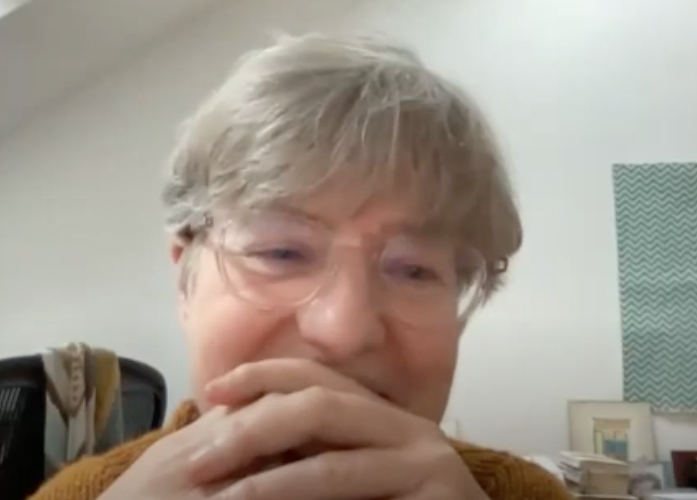
Some encouraging remarks for lesson 12
For those who are there already: In lesson 12 we are playing the full Paganini fragment! The most important thing is to stay aware what your left thumb is doing, are you still in contact with it? Can you use panoramic view, balance on your feet, thinking up, while playing these bars? Please do show me the position of your thumb in the end of the playing (after the last note). Don’t worry of some notes are out of tune, it does not need to be perfect at all, it’s just for me to see the process and what are difficulties and changes. I hope it will surprise you that it’s not so difficult to play this music without shoulder and/or chin rest :-). After these 12 lessons there will be an optional program of 6 more lesons purely on Alexander Technique while playing, but it’s not obliged to take part. Please do not forget the fill out the exit form after you uploaded the 12th lesson, as that will give me the data for the research. Thank you so much!
Please take your time
It is important that everyone in this experiment enjoys the curiosity we have, and take part in a joyful and playful way. In that way, we learn the best. Don’t try too much to ‘do it right’…and don’t hurry. If you need more time, just let me know, keep me informed, and we take a bit longer. No problem!
Happy New Year!
Tomorrow is Sylvesters day and I am looking back to a very happy year, both professionally and personally. Yesterday my little son (2,5 years) received his first violin, after repeatedly asking for one (see photo here under). This experiment has been one of the best things that happened to me in 2022, I am learning so much form all of your feedback and videos, it’s a really interesting process and who knows where it will lead to in the future, I see many possibilities. Thank you al so much! Wishing you a very good and musical New Year, in which we continue with our experiment. Looking forward very much!
Best regards, please let me know if you have questions,
Esther Visser
